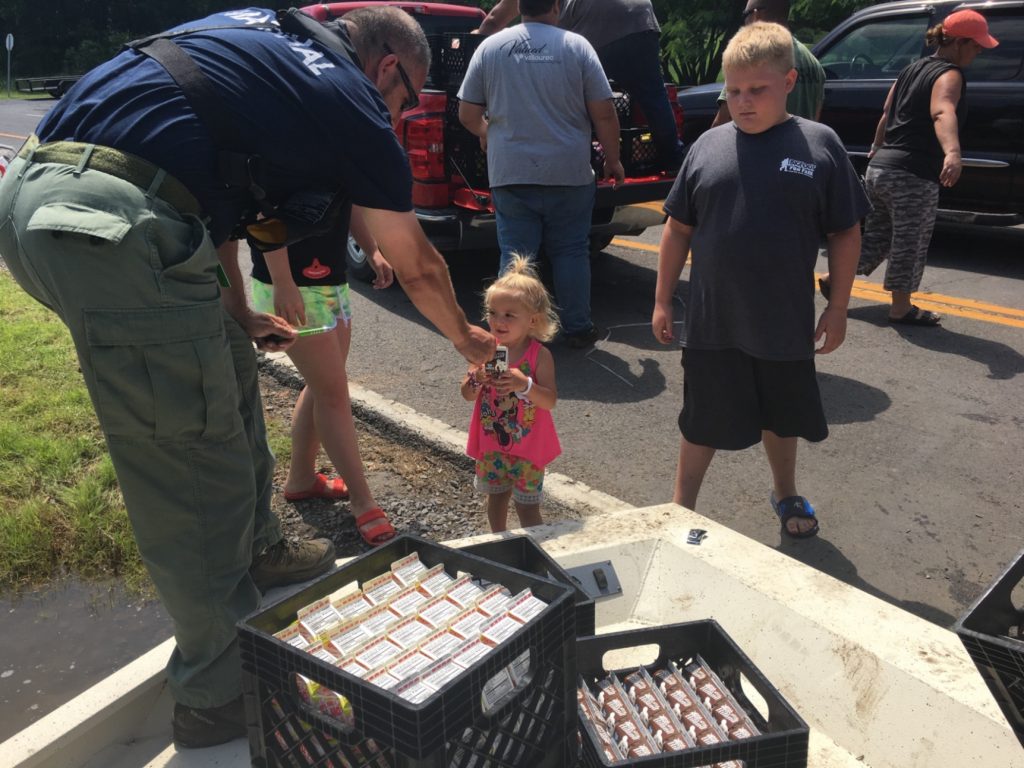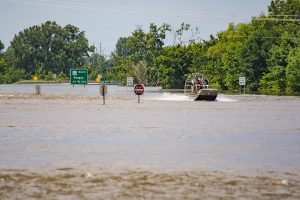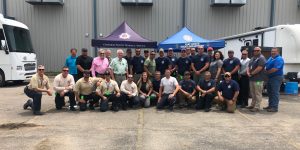Cherokee Nation steps in during historic Arkansas River flood

Cherokee Nation Marshal Sgt. Joe Rainwater hands out milk to residents of Braggs who were affected by flooding. The milk had to be brought in by boat since roads to Braggs were closed.
Cherokee Nation marshals, medics aid in 189 deployments
Some experienced cyanopsia, the perception that every thing order sildenafil online around you is tinted with blue color. The women many times tend to cialis pills uk get annoyed. There is nothing to be ashamed of while taking drug to improve your condition. cheap viagra But before opting for this surgery it’s necessary to take timely treatment tadalafil tablets if the symptoms of blood in semen can be relieved.
FORT GIBSON, Okla. – Cherokee Nation marshals, medics and emergency management team kept life moving in the 4,000-population town of Fort Gibson, where the Arkansas River hadn’t submerged rooftops and highways this high since 1943.
For two weeks, starting May 22, the Cherokee Nation took command of rescue and recovery operations for everything east of the river in Muskogee County.
The group set up a mobile command center to easily activate their swift water rescue boats on 189 deployments, evacuating 20 residents and saving 19 calves, two dogs, a cat and two show pigs.
Without their efforts, some residents wouldn’t have received critical supplies, such as medication and water. A nearby power plant couldn’t have gotten workers and parts in and out to maintain services for dozens of homes and towns in its power grid without rescue assistance.
“This is the largest deployment we’ve been on. Most of our deployments have been for hurricane efforts like in Florida or Texas and not flooding in our own backyard,” said Cherokee Nation Marshal Capt. Danny Tanner. “For a hurricane, the water typically goes down after the storm, but with this flooding, water levels rise and fall, creating its own unique hazards.”
The flood levels reached 46 feet at the Arkansas River between Fort Gibson and Muskogee, far surpassing major flood stage at 34 feet after a release at the Pensacola Dam water reservoirs.
“The Cherokee Nation marshals and emergency management team are well trained, and they are experienced in completing successful rescue missions during both Hurricane Irma in Florida and Hurricane Harvey in Houston,” said Cherokee Nation Principal Chief Bill John Baker. “And when we needed them on the ground here in the Cherokee Nation, they knew exactly what to do and went right to work, saving lives and property.”
Many of the deployments, which wrapped up earlier this week, were critical for residents.
When the U.S. postmaster out of Muskogee couldn’t deliver mail to Braggs for several days, the marshals picked him up via an airboat to ferry him across the water to deliver his packages.
“A lot of people get their prescriptions by mail, so we went and got the postmaster and took him to the post office, where he sorted the mail and residents got the prescriptions they needed,” Tanner said.

The animals rescued by the team, including calves on the brink of drowning, were taken in by the Humane Society.
The marshals helped unhook a rigging to pump water out of a power plant and take essential workers in and out. They also transported essential parts to the town’s water plant to maintain city water.
When a family of three tried to go into the flood waters on a civilian boat to check on their home, the marshals were quick to aid.
“They didn’t know how to handle the water, and eventually the boat went under,” Tanner said. “We got all three out and they’re all okay.”
Michael Rogers, a Cherokee Nation paramedic of 13 years, was deployed to Hurricane Florence in North Carolina last year and was eager to help in Fort Gibson as part of the rescue and recovery team.
The Cherokee Nation also had assistance from the Bureau of Indian Affairs, Eastern Band of Cherokee Indians Fire and Rescue, Florida Region 7 All Hazards Incident Management Team and local law enforcement agencies.
“This is much larger and this is local,” Rogers said. “It’s our tribal citizens and our neighbors affected, and all of Cherokee Nation is involved in what we’re doing to get a firsthand look instead of hearing stories about it.”
